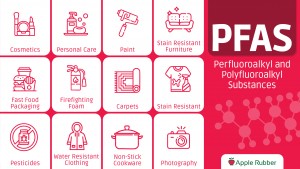Per- and poly-fluoroalkyl substances (PFAS) are a diverse group of chemicals characterized by carbon-fluorine bonds, which are the strongest chemical bonds in organic chemistry. Recent regulatory changes have primarily focused on specific product categories, including carpets, firefighting foam, upholstery, cosmetics, cookware, textile treatments, cleaning products, and food packaging.
Understanding Fluoropolymers
Fluoropolymers represent a distinct subset of PFAS with unique characteristics:
- Definition: Fluorocarbon-based polymers with multiple carbon-fluorine bonds
- Essential Applications: Critical for numerous industries including automotive, aerospace, electronics, medical technology, renewable energy, and chemical processing
- Regulatory Treatment: Growing trend to regulate fluoropolymers separately due to their different environmental impact profile
PFAS Classification by Structure
- Long-chain PFAS: 6 or more carbon atoms; solid at room temperature
- Short-chain PFAS: 4-6 carbon atoms; liquid or gas at room temperature
- Key Differentiators: Stability, size, and mobility characteristics
- Regulatory Approach: Scientific evidence supports different regulatory treatment based on these structural differences
U.S. State Regulations
Maine
Implementation Timeline:
- 2026: Ban on cleaning products, cookware, cosmetics, dental floss, juvenile products, menstruation products, textile articles (with exemptions), ski wax, and upholstered furniture
- 2029: Label disclosure required for artificial turf and outdoor apparel
- 2032: Comprehensive ban unless granted “currently unavoidable use” (CUU) status
- 2040: Specific regulations for vehicle-related applications
Minnesota
- Currently implementing Amara’s Law
- 2024: Preparation of draft rules
- 2032: Complete ban on products with intentionally added PFAS
Connecticut
Implementation Timeline:
- January 2026: Disclosure requirements for outdoor apparel
- July 2026: Ban on multiple product categories including apparel, carpets, cleaning products, cookware, cosmetics, and others
Colorado
PFAS Chemicals Consumer Protection Act Timeline:
- January 2024: Ban on carpets, rugs, fabric treatments, juvenile products, oil and gas products
- January 2025: Ban on cosmetics, indoor textiles, indoor furniture
- January 2027: Ban on outdoor textiles and furniture
California
- January 2023: Ban on paper-based food packaging with regulated PFAS
- January 2025: Ban on textile and cosmetic articles containing regulated PFAS
Washington
- January 2025: Implementation of Cycle 1 restrictions
- Future restrictions planned under Cycle 1.5 for cleaning products, waxes, cookware, and sealants
International Regulations
Canada
- Developing a refined approach that excludes fluoropolymers from broad PFAS definition
- Moving toward individual assessment of fluoropolymers
European Union
- Multi-country initiative led by Germany, Netherlands, Sweden, and Denmark
- Goal: Regulate PFAS by 2025
- Target: Ban on non-essential PFAS by 2030
- Current Status: Exploring alternative restriction options, particularly for fluoropolymers
United Kingdom
- HSE conducting two-year analysis of regulatory options
- Focus on developing appropriate management strategies
Future Outlook
The regulatory landscape continues to evolve as jurisdictions gain better understanding of PFAS impacts on human health and the environment. Expect continued refinement of regulations with potential differentiation between various PFAS categories based on their specific characteristics and applications.
References:
Asif Aleem, Cy Genna, Jenny Liu: (2024). Chemours™ Staying Ahead of PFAS Regulations [webinar]. Chemours™
